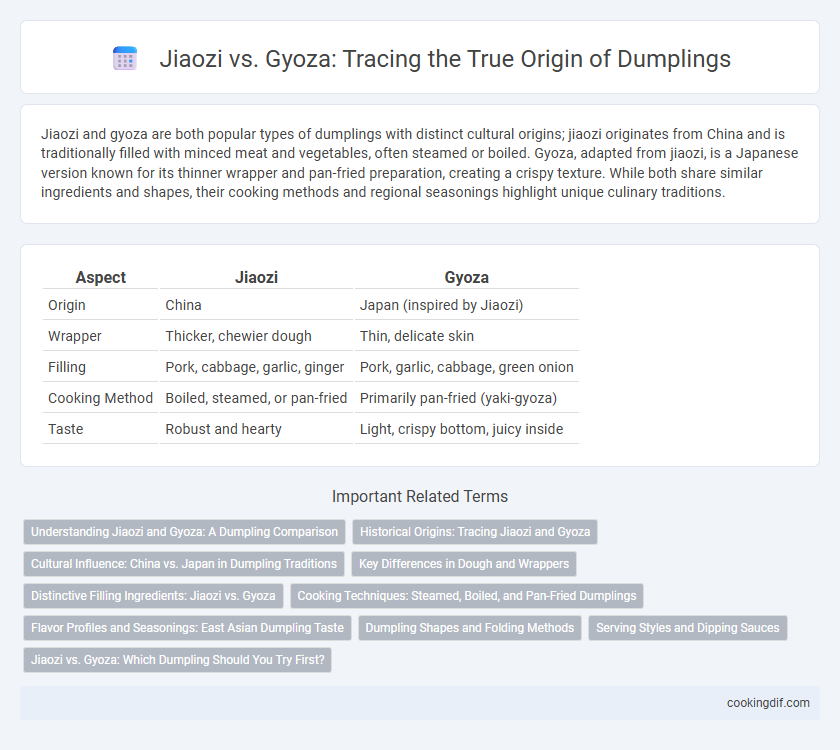Jiaozi and gyoza are both popular types of dumplings with distinct cultural origins; jiaozi originates from China and is traditionally filled with minced meat and vegetables, often steamed or boiled. Gyoza, adapted from jiaozi, is a Japanese version known for its thinner wrapper and pan-fried preparation, creating a crispy texture. While both share similar ingredients and shapes, their cooking methods and regional seasonings highlight unique culinary traditions.
Table of Comparison
| Aspect | Jiaozi | Gyoza |
|---|---|---|
| Origin | China | Japan (inspired by Jiaozi) |
| Wrapper | Thicker, chewier dough | Thin, delicate skin |
| Filling | Pork, cabbage, garlic, ginger | Pork, garlic, cabbage, green onion |
| Cooking Method | Boiled, steamed, or pan-fried | Primarily pan-fried (yaki-gyoza) |
| Taste | Robust and hearty | Light, crispy bottom, juicy inside |
Understanding Jiaozi and Gyoza: A Dumpling Comparison
Jiaozi and Gyoza are both traditional dumplings with roots in East Asian cuisine, but they differ in origin and preparation. Jiaozi, originating from China, typically features a thicker wrapper and a variety of fillings including pork, cabbage, and chives, often boiled or steamed. Gyoza, a Japanese adaptation influenced by Jiaozi, usually has a thinner, crisper wrapper and is commonly pan-fried, featuring fillings like ground pork, garlic, and ginger for a distinct flavor profile.
Historical Origins: Tracing Jiaozi and Gyoza
Jiaozi, originating in Northern China during the Eastern Han Dynasty, symbolize over 1,800 years of culinary tradition reflecting Chinese culture and festive customs. Gyoza, introduced to Japan in the early 20th century, evolved from Jiaozi by adapting to local tastes, featuring thinner wrappers and a stronger garlic flavor. Both dumplings highlight the cultural exchange between China and Japan, showcasing unique historical adaptations while maintaining their shared culinary roots.
Cultural Influence: China vs. Japan in Dumpling Traditions
Jiaozi, originating from China, reflects centuries of culinary evolution deeply embedded in Chinese culture, often associated with celebrations like Lunar New Year. Gyoza, inspired by jiaozi but adapted by Japanese tastes, emphasizes thinner wrappers and a crispier texture, showcasing Japan's local ingredient preferences and cooking techniques. The cultural influence of China on dumpling traditions is foundational, while Japan's gyoza highlights regional innovation and adaptation within Asian cuisine.
Key Differences in Dough and Wrappers
Jiaozi dough is typically made from wheat flour and water, resulting in a thicker, chewier wrapper that holds up well to boiling or steaming. Gyoza wrappers are thinner, often containing more finely milled flour and sometimes egg, producing a delicate, crisp texture when pan-fried. The difference in wrapper thickness and ingredients significantly impacts the cooking methods and texture, with jiaozi favoring a heartier bite and gyoza delivering a light, crispy finish.
Distinctive Filling Ingredients: Jiaozi vs. Gyoza
Jiaozi typically features a filling of ground pork, napa cabbage, garlic chives, and ginger, emphasizing rich, hearty flavors rooted in Chinese culinary traditions. Gyoza, influenced by jiaozi but tailored to Japanese tastes, often includes ground pork, cabbage, garlic, and a hint of sesame oil or soy sauce, creating a lighter and slightly sweeter profile. The distinctive use of ingredients like garlic chives in jiaozi versus the sesame oil in gyoza highlights the cultural and regional adaptations in their fillings.
Cooking Techniques: Steamed, Boiled, and Pan-Fried Dumplings
Jiaozi and Gyoza differ in cooking techniques, with jiaozi traditionally steamed or boiled to preserve a soft, tender texture, while gyoza are primarily pan-fried to create a crispy bottom and juicy interior. Steaming jiaozi ensures a more delicate, moist dumpling, commonly enjoyed during Chinese festivals like Lunar New Year. In contrast, gyoza's pan-fried method, known as yaki-gyoza, highlights a combination of crunchy and tender textures, popular in Japanese cuisine and street food culture.
Flavor Profiles and Seasonings: East Asian Dumpling Taste
Jiaozi and Gyoza differ notably in their flavor profiles, with Jiaozi emphasizing a balanced blend of soy sauce, ginger, and garlic for a savory, umami-rich taste that reflects traditional Chinese seasoning. Gyoza incorporates garlic chives and sesame oil, offering a sharper, more aromatic flavor characteristic of Japanese culinary influence. Both utilize ground pork or vegetables, but the seasoning variations highlight the distinct East Asian regional tastes shaping each dumpling's unique identity.
Dumpling Shapes and Folding Methods
Jiaozi and Gyoza dumplings differ significantly in shape and folding techniques, reflecting their culinary origins. Jiaozi typically feature a crescent shape with pleated edges, created by pinching and folding the dough wrapper to form multiple pleats along one side, enhancing both texture and visual appeal. Gyoza are smaller with a more uniform, thinner wrapper, folded into half-moon shapes with tighter, fewer pleats that seal in juicy fillings, optimizing pan-frying to achieve crisp bottoms and tender tops.
Serving Styles and Dipping Sauces
Jiaozi and Gyoza, both popular dumpling varieties, differ significantly in serving styles and dipping sauces, reflecting their cultural origins. Jiaozi, a staple in Chinese cuisine, are typically boiled, steamed, or pan-fried and served with a dipping sauce made of soy sauce, vinegar, and minced garlic or ginger, emphasizing savory and tangy flavors. Gyoza, originating from Japan, are predominantly pan-fried to achieve a crispy bottom, accompanied by a dipping sauce combining soy sauce, rice vinegar, and chili oil, offering a balanced and slightly spicy taste profile.
Jiaozi vs. Gyoza: Which Dumpling Should You Try First?
Jiaozi, traditional Chinese dumplings, feature a thicker, chewier dough and are often boiled, steamed, or pan-fried with a variety of fillings like pork, cabbage, and chives, reflecting centuries of culinary history. Gyoza, the Japanese adaptation, typically has a thinner wrapper and is pan-fried to achieve a crispy bottom with a juicy interior, commonly filled with ground pork, garlic, and cabbage, influenced by Chinese Jiaozi but with distinct seasoning. Choosing between Jiaozi and Gyoza depends on your preference for texture and flavor intensity: Jiaozi offers a heartier, more diverse filling experience, while Gyoza excels in crispy texture and subtle umami notes.
Jiaozi vs Gyoza for dumpling origin Infographic

 cookingdif.com
cookingdif.com